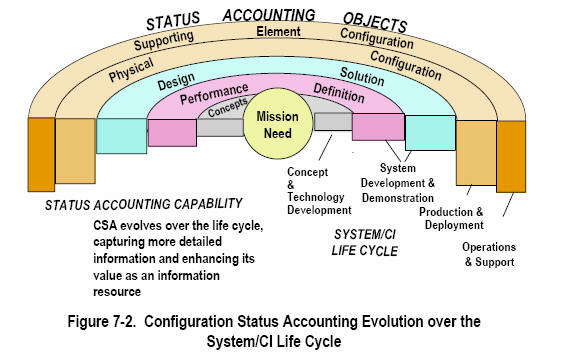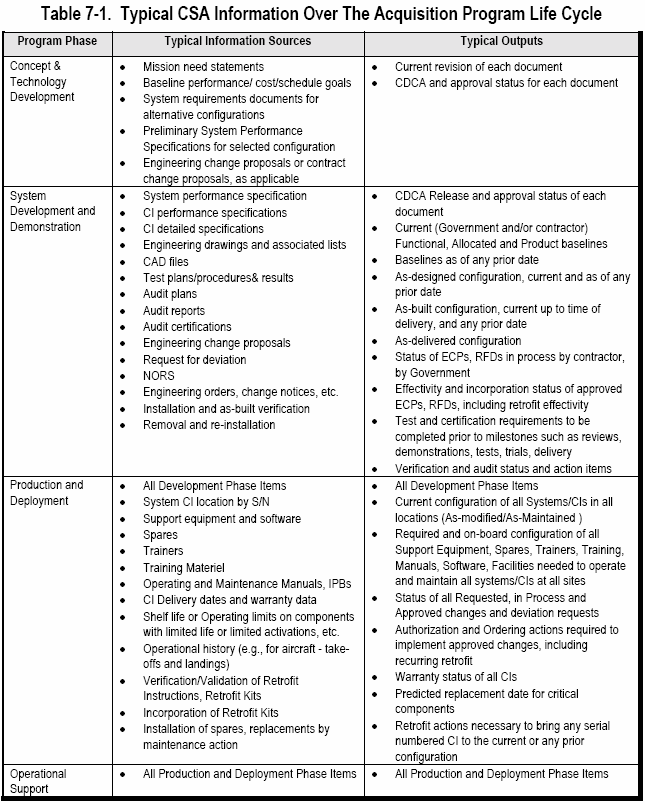MIL-HDBK-61A: Configuration Status Accounting (CSA)
< Previous | Contents | Next >
7.2 CSA Concepts and Principles.
Because the complexion of the objects about which status accounting information is collected changes during the item life cycle, as shown in Figure 7-2, the specific outputs will vary. The inputs and outputs in Figure 7-1 may be thought of as generic categories for which there are different specifics in each phase.
The high level summary of CSA tasks shown in the center of Figure 7-1 reflect the functional performance capabilities of a complete CSA process which includes both Government and contractor activity.

Some of these tasks also may not span the entire life cycle. The allocation of responsibilities within these functions (tailoring) must be accomplished during the CM planning activity and should take into account the degree to which the Government information technology infrastructure has been upgraded.
Contractor Integrated Technical Information services (CITIS) is the CALS (Continuous Acquisition Life Cycle Support) term used to describe the interfacing technology enabling the Government to access data from contractor systems and to transfer data electronically [Details: Section 7]. Under such an environment, information will reside where it is most economical and will be accessible for use, on line, by all who have appropriate data rights and are granted access privileges. Contractor and Government CSA information could be merged in what would appear to be a seamless (virtual) database. The goal of a fully integrated data environment in which Government and contractors share information is technically within reach. In such an environment, data input by one source is accessible to all associated organizations in the program chain from subcontractors to contractors, government acquisition offices, depots, and maintenance and other field activities.
Web-enabled tools and systems linking Government and contractor data repositories for retrieval of archived data, would be the cheapest possible operational scenario with the most accurate and easily accessible information. Queries would yield such information as
- The as-designed, as-built, as-delivered, or as-modified configuration of any serial number of the product as well as any component within the product.
- For software, the as-delivered, as modified, as tested configuration of any CSCI, as of any date.
- The current status of any change, the history of any change, and the schedules for and status of verifications and audits, as well as resultant action items
- Metrics (performance measurements) on CM activities for use in monitoring the process and in developing continuous improvements. To the extent that contractor and Government data sources are integrated, the DoD CM Manager could also monitor performance trends at the contractor.
All of the information required to accomplish the complete CSA function can be captured and supplied using commercial configuration management and product data management tools. With appropriate links to logistics and maintenance systems, the following evolution of CSA information shown in Table 7-1 is possible over the life cycle.
Some of the above status accounting inputs and outputs are routinely available in a contractor's database, some are specialized information that the Government (or a third party contractor to the Government) would need to access. Other information is inherent to Government databases and needs to be shared between Government and contractor. The amount and type of design information in the data base to which the Government needs access rights varies based on the documentation which the Government controls. The division of responsibility was simple when the Government baselined and controlled the Product Baseline on all weapon systems and organically supported each CI. In the environment of acquisition reform, the determination is more complex and cannot be made generically. The Government will control detailed design data only for specifically authorized items. Otherwise the Government will normally control only the performance requirements, which include interface and envelope requirements. The Government will take delivery of a technical data package (TDP) originals (and transfer CDCA responsibility) only if the Government baselines the configuration and acquires the TDP. If the Government chooses not to transfer CDCA responsibility to the Government, it may elect to take delivery of a copy of the TDP to provide documentation for logistics support, modification analysis, demilitarization, and other purposes. [Detail: Section 7.5.1, 7.7.1, 7.7.2]

The government's range of CSA access is normally limited to data for which they have configuration control and data for items for which they provide logistic support. The contractor normally monitors the data for those items it supports. Some of the information that must be shared concerns items under warranty. It is important for the Government to know what the warranty period is on each item that needs repair, as well as the date that the warranty began for each serial number. A ready reference to this data by logistics support personnel could result in cost savings to the Government if it is used to determine the priority used to ship items back to the manufacturer for repair. This is an instance of the Government adapting to standard industry practice.
New and innovative methods of capturing the configuration of installed and spare items and software versions are becoming commonplace. These methods include bar coding and the interrogation of embedded identification via on-equipment data busses and on-board support equipment. The technology for this process is now commonplace in the commercial personal computer industry and the automotive industry.
The information that is loaded into CSA is considered "meta-data", i.e. information about the data. It provides status and cross-references actual TDP information that is stored digitally in contractor and Government data repositories. Each design activity establishes a document repository for the CIs developed, produced or maintained by an OPR under their authority. The data repositories are normally maintained by the inventory control point responsible for the provisioning/supply support of the CI. (For example, the Weapon Systems Files (WSF) at the Ships Parts Control Center, Aviation Supply Office (ASO), and the DLA, Air Force and Army supply centers. Each DoD Activity responsible for a data repository would identify the repository by listing it in MIL-HDBK-331.) Current CSA records are maintained in such range and depth as to be responsive to the requirements of the various support activities for access to configuration information. The data repository is the central point for the collection, storage, processing, and promulgation of this data. Configuration information should be available on a request basis, either by hard copy or on-line computer access. The CSA records are used as "best source" input data for purchase data packages, design studies, and management analyses requested by the supporting/design activities. In particular, the CSA metadata records must accurately reflect the status of the configuration documents (specifications, drawings, lists, test reports, etc.) maintained in the document repositories.
For correct application of this information, see NOTE on Contents page